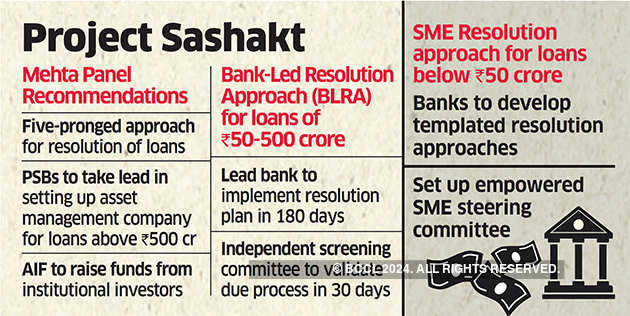

NEW DELHI: State-run banks will take the lead in setting up an asset management company (AMC) for the resolution of loans above Rs 500 crore as part of further efforts aimed at rescuing bad assets and restoring lenders to health so that they can focus on credit growth to push forward India's ongoing economic recovery.
The initiative will be run by the banks without government involvement, will be in harmony with all current laws and will function as an adjunct to the Insolvency and Bankruptcy Code (IBC) process.
Finance minister Piyush Goyal said Monday that government had accepted these proposals that were contained in a report submitted by a committee of bankers led by Punjab National Bank chairman Sunil Mehta. There is no plan for a bad bank, he added. The state-run lenders will also set up alternate investment funds (AIFs) to raise money and back the asset management company.
“An independent AMC would be set up, and AIF would raise funds from institutional investors,” said Goyal, adding that the government will have no role. The initiative has been dubbed Project Sashakt.
“AMC/AIF will become a market maker and ensure healthy competition, fair price and cash recovery,” he said.
There could be more than one AMC, said Goyal. AIFs will be set up under Category 2 of the Securities and Exchange Board of India (Sebi) guidelines, which include private equity funds (PE) funds and funds for distressed assets, said a senior banker, adding that banks themselves can invest in these funds if they wish to participate.

State Bank of India, the country’s largest bank, said it will be open to taking the lead on Project Sashakt. “Each bank can take its own decision—we are ready to take the initiative,” said SBI chairman Rajnish Kumar.
Goyal noted that the move will lead to banks’ focus coming back to credit growth and they will be able to lend to good borrowers.
The report recommends a fivepronged approach for loans up to Rs 50 crore, loans of Rs 50-500 crore and loans above Rs 500 crore.
There are about 200 accounts that owe more than Rs 500 crore to banks for a total exposure is about Rs 3.1lakh crore.
The committee has also suggested an asset trading platform for both performing and non-performing assets.
Under the SME Resolution Approach (SRA), loans up to Rs 50 crore would be dealt using a templated approach supported by a steering committee and the resolution will be completed in a time-bound manner within 90 days.
The Mehta committee has further proposed a Bank Led Resolution Approach (BLRA) for loans between Rs 50 and Rs 500 crore. Financial institutions will enter into an inter-creditor agreement to authorise the lead bank to implement a resolution plan in 180 days.
The lead bank would then prepare a resolution plan including the empanelment of turnaround specialists and other industry experts for operational revival of the asset. In case the lead bank is unable to complete the resolution process within 180 days, the asset will be resolved through the Insolvency and Bankruptcy Code (IBC).
Goyal said the recommendations of the committee are complaint with extant regulations and aim at an operational turnaround to retain the value of assets created for national benefit.
The finance minister said that the recommendations further aim to prevent job losses from foreclosures and create additional employment by reviving businesses.
“This will ensure a robust governance and credit architecture is put in place to prevent similar build-up of NPAs in the future,” he said.
The gross nonperforming assets (NPAs) of state-run banks stood at Rs 7.77 lakh crore at the end of December 2017.